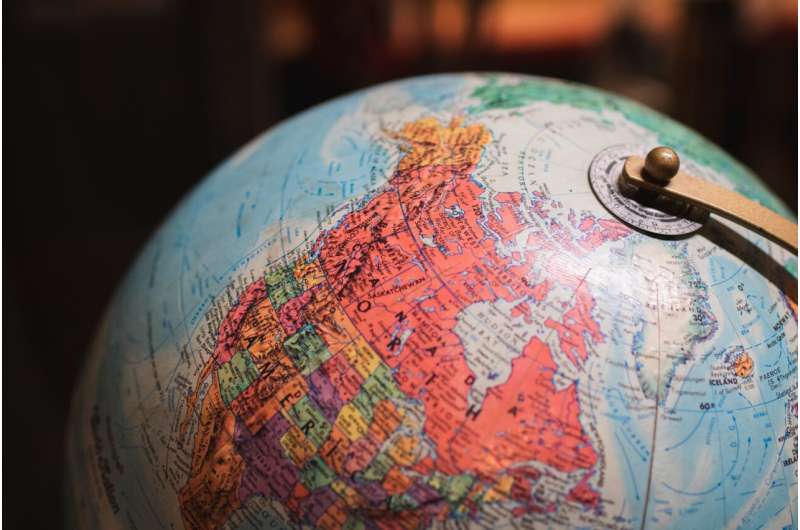This article has been reviewed according to Science X's editorial process and policies. Editors have highlighted the following attributes while ensuring the content's credibility:
fact-checked
trusted source
written by researcher(s)
proofread
After the migrant deaths in Akwesasne, Canadian immigration law must reckon with its colonial history

On March 29, two families of four died while attempting to cross the St. Lawrence River from Canada to the U.S. Their bodies were found in Akwesasne Mohawk territory which straddles the Canada-United States border.
Media coverage quickly began to frame the fatal incident as an issue of illegal human smuggling. Reports characterized the Akwesasne Mohawk territory as a "smuggling hotspot" and an "ideal location for trafficking of humans and contraband."
Articles featured exposés on migrants who helped smuggle people across the border as well as Akwesasne individuals who assisted in crossings rendered illegal by U.S. and Canadian governments.
This type of news coverage, which focuses on individuals, allows governments on both sides of the border to elude responsibility for enacting policies which limit options to cross borders legally, make irregular crossings more dangerous and deflect blame onto those facilitating those crossings.
But perhaps the most glaring omission in media coverage is any meaningful reflection on what it means for this tragedy to occur on Indigenous territory.
Indigenous communities and the border
Scholars have drawn attention to historical amnesia when it comes to colonialism and racism in the western media coverage of migration. Unless this amnesia is addressed, the precarious conditions, suffering and death that many migrants fleeing persecution and displacement face will continue.
The Akwesasne tragedy must be understood in the context of colonial history and the imposition of the U.S.-Canada border on Indigenous nations.
The 1783 Treaty of Paris established a rough initial boundary between American settler claims and British settler claims, which ran through the St. Lawrence River, present-day Akwesasne territory and the Great Lakes.
The 1794 Jay's Treaty codified the inherent rights of Indigenous Peoples to move freely across the border and to carry out trade and commerce. Yet, in practice, neither colonial government expended much effort to monitor or restrict the movement of people across the boundary.
But as American and Canadian governments hungrily expanded to the west, the idea of freedom of movement for Indigenous Peoples began to fade away in the face of settler colonial objectives.
Instead, Indigenous Peoples were made foreigners in their own land with mobility and land rights inferior to those of European settler migrants. After the Métis-led 1885 North-West Rebellion was put down, Canada implemented a regime of racialized migration control known as the Indian pass system.
This system made it illegal for Indigenous people to leave their reserve without a pass issued by an Indian agent for a specific duration and purpose. Those caught violating pass conditions faced jail time and could be "deported" back to their reserve. The pass system remained enforced in some locations until the 1940s.
As Historian Benjamin Hoy writes, "[f]rom the very outset, Canada and the United States believed that building a national border on Indigenous lands required erasing pre-existing territorial boundaries."
Colonial dispossession
Canadian immigration law has historically served as a key mechanism of colonial dispossession. The first Immigration Act of 1869 was designed to promote "a liberal policy for the settlement and colonization of the uncultivated lands," particularly as part of westward expansion.
It did this by actively encouraging white European settlers to come to Canada by granting them protections and rights. These included travel support, affordable homesteads, no removal after arriving and naturalization after three years' residence.
Additionally, the 1872 Dominion Lands Act granted large plots of land to any settler who paid a small fee and made certain improvements on the land. Yet this land was not Canada's to claim, grant or sell, but rather belonged to Indigenous nations whose traditional territories were swept up through military violence and unfair treaties.
Undermining Indigenous self-determination
Canada has continued to assert unilateral sovereignty in immigration while simultaneously erasing diverse Indigenous laws and customs.
This came to a head in the 2006 federal court case of Sister Juliana Eligwe, a Nigerian nun in Canada who faced deportation. Sister Juliana claimed asylum in Canada, saying that she would face persecution if she returned to Nigeria.
Sister Juliana worked as live-in nanny and housekeeper. She also volunteered with the Sandy Bay Ojibway First Nation in Manitoba where she supported youth experiencing the emotional trauma of losing peers and loved ones to suicide.
In a bid to prevent her deportation, the First Nation made Sister Juliana a band member. The First Nation's lawyers argued that Canada's Immigration and Refugee Protection Act should be read in a way that recognized the inherent right of Indigenous communities to determine political membership, as well as any member's right to enter and remain in Canada.
The court rejected that argument, saying the First Nation was attempting "to usurp the discretion of the Minister of Citizenship and Immigration by accepting non-residents as band members and thereby granting them permanent resident status."
Ultimately, Sister Juliana was deported to Nigeria, another country deeply affected by the legacies of British colonialism. In siding with the federal government, the court effectively took away the First Nation's right to decide on its own membership.
A key part of the truth and reconciliation process is for settlers to acknowledge treaty relationships with Indigenous communities and their treaty rights to be on this land. It is untenable that immigration policy remains untouched by the obligations of reconciliation and decolonization.
To help avoid more tragedies at the border, Canada must make a commitment to reckon with its unfair and colonial history of immigration. One of the first steps is to acknowledge and respect Indigenous sovereignty, laws and treaty relations when it comes to immigration.
Provided by The Conversation
This article is republished from The Conversation under a Creative Commons license. Read the original article.![]()





















